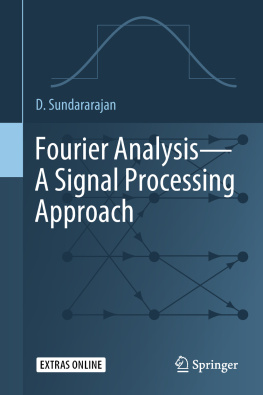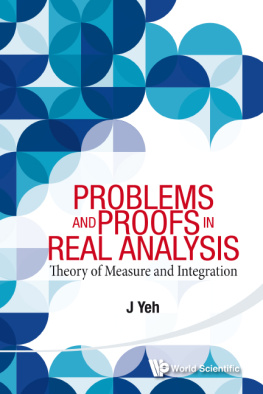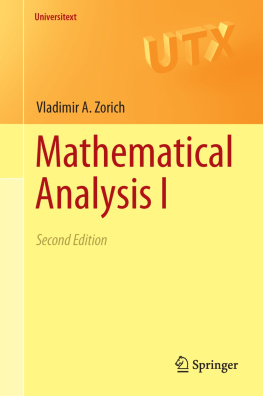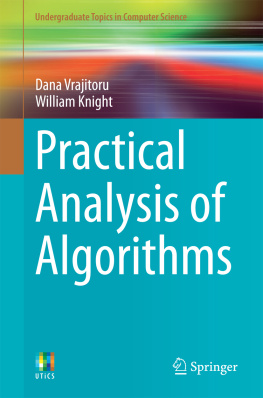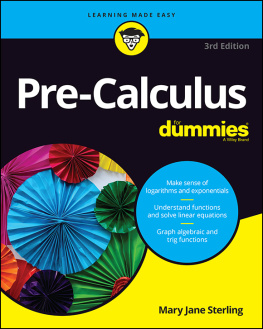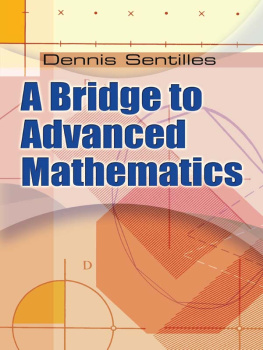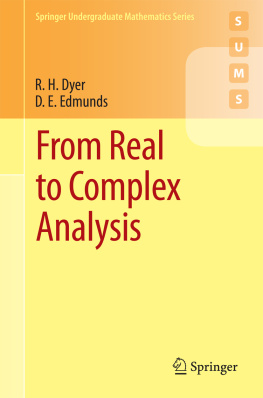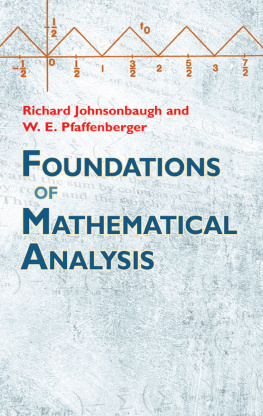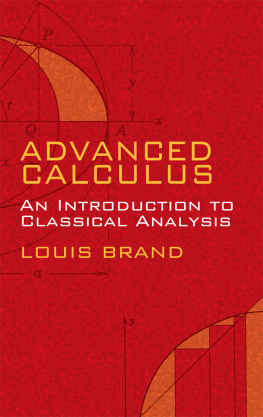INTRODUCTION TO
REAL ANALYSIS
MICHAEL J. SCHRAMM
Le Moyne College
DOVER PUBLICATIONS, INC.
Mineola, New York
Copyright
Copyright 1996 by Michael J. Schramm
All rights reserved.
Bibliographical Note
This Dover edition, first published in 2008, is an unabridged republication of the work originally published in 1996 by Prentice-Hall, Inc., Englewood Cliffs, New Jersey.
Library of Congress Cataloging-in-Publication Data
Schramm, Michael J. (Michael John)
Introduction to real analysis / Michael J. Schramm. Dover ed.
p. cm.
Originally published: Englewood Cliffs, N.J. : Prentice Hall, 1996.
Includes bibliographical references and index.
ISBN-13: 978-0-486-46913-3
ISBN-10: 0-486-46913-1
1. Mathematical analysis. 2. Functions of real variables. I. Title.
QA300.S374 2008
515dc22
2008024901
Manufactured in the United States by Courier Corporation
46913102
www.doverpublications.com
Contents
Preface
This text is an introductory course in real analysis, intended for students who have completed a calculus sequence. It is also designed to serve as preparation for advanced mathematics courses of many sorts. Though there are occasional references to it in exercises, linear algebra is not specifically a prerequisite for this text. Nevertheless, the changing role of linear algebra in the undergraduate curriculum is one of the main reasons this book comes to be the way it is. In the past, a first course in linear algebra was generally considered to be the place where one "learned to do proofs." The mathematics curriculum has gradually changed, though, and proofs as such are no longer the main focus of the typical linear algebra course. As a result, a student's first extensive experience with the logical and organizational skills necessary for the successful construction of proofs is often delayed until they find themselves in courses in which success is predicated on possession of those very skills.
Textbooks have been slow to adapt to these changes. This book provides a pathway from the calculus course to real analysis (and beyond) in which the discussion of the construction of proofs is a continuing and central theme. Throughout the text (but most especially in ), proofs are not simply presented in final form. Rather they are shown as works-in-progress; they are built, and their construction is discussed along with their final content. While learning real analysis, the student will, it is hoped, also learn something about the workings of the mind of a mathematicianinvaluable information if one is to become a researcher in or a teacher of mathematics, or both, but information that is often overwhelmed by the demands of the subject at hand.
The text is organized into four parts. The material of is devoted to discovering how they are different.
is such that after its first four chapters are discussed, the rest may be treated in any order and at the discretion of the instructor. The structure provided by the Big Picture allows the option of showing that the important properties of the real number line do not exist in isolation; they are in fact equivalent.
is a selection of topics in real function theory, investigated as natural outgrowths of questions readily understood by the student. The instructor has great latitude to choose topics in the second half of the text, and coverage of this material can range from an intensive reconstruction of calculus to a discussion approaching current research topics.
The exercises in the text are many and varied. They range from the fairly routinechecking steps omitted from examples and observing mechanical results at workto completion of partial proofs from the text to extended projects, some of which border on current research. There are questions in which the student is asked simply to discuss a statement, or to explain to their own satisfaction why something is true or false, free from the restrictions of a formal proof. There are questions in which the student is asked to find flaws in incorrect (though possibly convincing) "proofs," and questions in which the student is asked to reconsider their own proofs in light of new information. Most importantly, the exercises are an integral part of the text. Regular and meaningful cross-referencing reminds the student of the unity of the subject and highlights their own active role in its development. Furthermore, the exercises themselves constitute part of the ongoing study of the workings of the mathematical mind, as the student is often led from one topic to another in a way that suggests, it is hoped, that no matter how many answers one finds, there are always more questions to be asked.
The diagram below may be interpreted like this: The overall flow of the subject is from top to bottom. The material of Gratitude, like proofs, should sometimes follow the forward-backward method. I am eternally grateful to Professor Ronald Shonkwiler of the Georgia Institute of Technology for starting me on my way to becoming a mathematician, and to Professor Daniel Waterman and the late David Williams of Syracuse University for doing their best to help me finish the journey. In the present, I am indebted to Jim Spencer of the University of South Carolina at Spartanburg and Robert E. Zink of Purdue University, and others whose identities I will never know, for their careful and thoughtful reviews of the manuscript of this book. Their suggestions have much improved the end result. For the future, I wish to thank the students who have been so tolerant during the development of this text. They have, with the unerring radar available only to those to whom a subject is new, corrected shocking slews of errors, and have, for the most part, helped me overcome my tendency to write questions in which it is necessary to do part (b) before part (a). They have also, much as was hoped, asked lots of questions, and many of the exercises in the text were proposed by students in the course. It can be said with equal validity in regard to all three of these groups of people, that most of what is good here is theirs, while the remaining errors and oversights are mine alone.
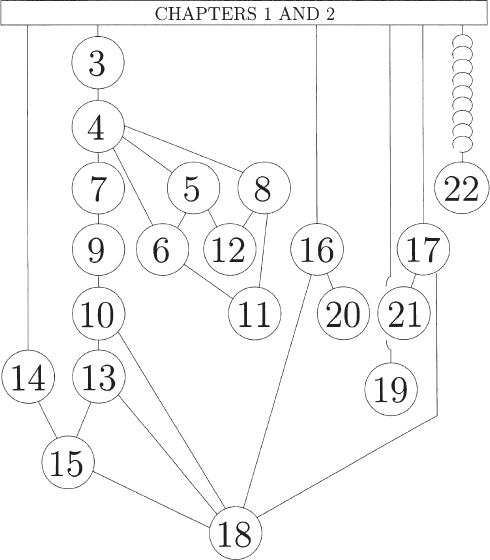
Part One
Preliminaries
We begin our work with a discussion of the construction of proofs. Writing proofs, of course, is the heart of mathematics. If there were always direct, mechanical processes for writing proofs, though, mathematics would not be nearly so fascinating. We will find that proofs need not be as mysterious as they might seem and that we can smooth the way considerably by making use of some basic organizational schemes.
The rest of the first half of the book is best understood by thinking of what we will call the Big Question: How are the real numbers different from the Rational Numbers? We will tackle this in two stages. In of the book, we examine the differences between them and answer the Big Question. Our efforts will be richly rewarded. We will find that the property that distinguishes the real number system from the rational number system is precisely what makes calculus work.
Through all of this we will never say what the real numbers actually are! That we can consider working this way is one of the remarkable features of mathematics. We can study how the real numbers work, blissfully unconcerned with what they are. We can solve the crime, so to speak, without ever knowing the suspects. We will finally meet the real numbers at the very end of the book. Agatha Christie would be proud. If we don't even know what they are, how can we hope to say that the real numbers are different from the rational numbers? Like this: If an object



